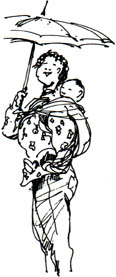 It is a pity to gloss over everything but one cannot leave out some gardens in the city which should be mentioned, apart from the Jardim de Camões (Camões Garden) and the Jardim do Lou Lim Ioc (Lou Lim Ioc Garden), like the Jardim da Flora (Flora Garden), situated at the foot of Colina da Guia (Guia Hill) along with the 'old' Pavilion which disappeared on the 13th of August 1931, from the impact of an explosion in an ammunition storehouse; the Jardim da Vitória (Victory Garden) in memory of defeating the Dutch who decided to invade Macao on the 24th of June 1622; the Jardim de Vasco da Gama (Vasco da Gama Garden); the Parque da Montanha Russa (Russian Mountain Park); etc. On the Taipa and Coloane Islands, though in a smaller number, the Jardim da Ponte-Cais (Jetty Garden) stands out for the interesting way it is laid out and for its figurative elements, along with the old fort at Taipa Island and near the monument which records the victims of the explosion on the frigate D. Maria II, which happened on the 29th of October 1850. In the same vein we have the Jardim do Carmo (Carmo Garden), bordered by the hundred year old church, the Jardim da Vila (Town Garden), and the garden lookout to the west with its nautical and rather bizarre themes, built in 1954 by the Administrator of the Municipal Council of the Islands at the time, António Maria da Conceição, who was also the project designer.
With or without historical references, gar-dens are a fundamental part of the development and a town's life, providing areas where people from different levels of society can mingle together and play an important role with regard to breaking social barriers. In Macao, where the high population density and small land mass does not allow an expansion of the habitable area, the houses are small and so the inhabitants, mainly those in the Chinese community, look for gardens which provide conditions that incentivate people to go there often and which essentially become used beyond the hours of daylight, anticipating the need for lighting and security police.
It is a pity to gloss over everything but one cannot leave out some gardens in the city which should be mentioned, apart from the Jardim de Camões (Camões Garden) and the Jardim do Lou Lim Ioc (Lou Lim Ioc Garden), like the Jardim da Flora (Flora Garden), situated at the foot of Colina da Guia (Guia Hill) along with the 'old' Pavilion which disappeared on the 13th of August 1931, from the impact of an explosion in an ammunition storehouse; the Jardim da Vitória (Victory Garden) in memory of defeating the Dutch who decided to invade Macao on the 24th of June 1622; the Jardim de Vasco da Gama (Vasco da Gama Garden); the Parque da Montanha Russa (Russian Mountain Park); etc. On the Taipa and Coloane Islands, though in a smaller number, the Jardim da Ponte-Cais (Jetty Garden) stands out for the interesting way it is laid out and for its figurative elements, along with the old fort at Taipa Island and near the monument which records the victims of the explosion on the frigate D. Maria II, which happened on the 29th of October 1850. In the same vein we have the Jardim do Carmo (Carmo Garden), bordered by the hundred year old church, the Jardim da Vila (Town Garden), and the garden lookout to the west with its nautical and rather bizarre themes, built in 1954 by the Administrator of the Municipal Council of the Islands at the time, António Maria da Conceição, who was also the project designer.
With or without historical references, gar-dens are a fundamental part of the development and a town's life, providing areas where people from different levels of society can mingle together and play an important role with regard to breaking social barriers. In Macao, where the high population density and small land mass does not allow an expansion of the habitable area, the houses are small and so the inhabitants, mainly those in the Chinese community, look for gardens which provide conditions that incentivate people to go there often and which essentially become used beyond the hours of daylight, anticipating the need for lighting and security police.
. </I></B>
</JZ>
<figcaption>DIDIER RAPHAEL BAYLE (°1955).1997. Watercolour. Collection of the artist. </figcaption></figure>
<p>
The new main roads, opened during the governorship of Tomás de Sousa Rosa and of others which followed, were planted with trees like the leafy <i>Ficus </i>variety, commonly known in Macao as ) 'Árvores do Pagode',Lat.: Ficus retusa) and Banyan Trees or ' St Joseph's Trees'(Port.: 'Árvores de St. José', Lat.: [Ficus Wightiana--?], Ficus virens -- (Ait.)). Before that, other species were introduced like the well known Red Acacia [a variety of Huisache, Cassia or Chinese Cinammon] (Port.: Acácia rubra, Lat.: Delonix regia -- (Raf.)) for example, originally from the Island of Madagascar, which fill the city every June with the vibrant colours of their red flowers.
'Árvores do Pagode',Lat.: Ficus retusa) and Banyan Trees or ' St Joseph's Trees'(Port.: 'Árvores de St. José', Lat.: [Ficus Wightiana--?], Ficus virens -- (Ait.)). Before that, other species were introduced like the well known Red Acacia [a variety of Huisache, Cassia or Chinese Cinammon] (Port.: Acácia rubra, Lat.: Delonix regia -- (Raf.)) for example, originally from the Island of Madagascar, which fill the city every June with the vibrant colours of their red flowers.
For many years the care and upkeep of urban green areas was under the authority of the Repartição Provincial de Obras Públicas (Provincial Department for Public Works) until October 1933 when the Repartição de Agricultura de Macau (Agricultural Department of Macao) was created, which incorporated the "[...] conservation and improvement of grasses and gardens in the Colony [... and...] installation and conservation of a botanical garden [... and also the...] installation of a herb garden in the Colony and a Museum of Agriculture." Of its attributes, it is very interesting to note the "[...] urgent planting of forests in the uncultivated areas on the Islands of Taipa and Coloane and their dependencies [... and the...] care of public gardens." As to the afore-mentioned Botanical Garden, it would remain the "[...] Jardim da Gruta de Camões [lit.: Camões' Grotto; i. e., Camões Gardens] and contain one or more of every botanical species in the Colony and all the exotic species possible to acclimatise there." Unfortunately however, the Agricultural Department of Macao would cease to exist in November 1936, returning green areas in the city of Macao to the Provincial Department for Public Works, a situation which continued until the 1960's when a mandate from the Governors Silvério Marques (1959-1962) and Nobre de Carvalho (1966-1974) succeeded in transferring these concerns to the Leal Senado (Municipal Council).
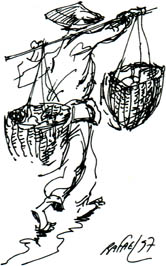
As far as the Islands were concerned, the responsibility of the green areas fell either on the Commanders of the Posto Militar (Military Post) or the Presidents of the Comissões Administrativas (Commissions) and the Câmaras Muncipais (Municipalities). The policy simply exemplified, as referred to in May 1882, the Administrator at the time, [José Corrêa de Lemos], who mentioned the existence of places to take over; or the request presented by the Comandante Militar das Ilhas (Military Governor of the Islands) when, in 1918, he advocated the planting of forty thousand Willow trees which was most likely not done.
As is apparent, in spite of energy and good will, the lack of adequately qualified personnel could not bring about good results, which is why it came as no surprise that during the time of the Governor Jaime Silvério Marques, the state of abandonment of the Colony's forests was officially recognised and the Islands of Taipa and Coloane were then passed on to being under the Serviços de Economia e Estatística Geral da Província (Services of the Economy and General Statistics of the Province). Finally, at the beginning of the 1960's (1962) the Brigada de Macau (Macao Brigade) of the Missão de Estudos Agronómicos de Macau (Mission of Agronomic Studies of Macao) instigated, with a scientific basis, the biggest project carried out in the Territory in terms of green areas: the forestation of the Islands of Taipa and Coloane, in which pioneering species like Pine (Port.: Pinheiro, Lat.: Pinus massoniana -- (Lambert)), Formosa Acacia [lit.] (Port.: Acácia da Formosa, Lat.: Acacia confusa-- (Merr.)) and Cassowary Tree or Casuarina (Port.: Casuarina, Lat.: Casuarina equisetifolia) were used. The Mission of Agronomic Studies of Macao would cease to exist in the middle of 1976, the time when the Serviços Florestais e Agrícolas de Macau (Department of Agriculture and Forestry of Macao) was created who gave continuity to the project and began the forestation of the Islands in 1982, which, from January 1986 onwards, would be carried on by the Câmara Municipal das Ilhas (Municipality of the Islands). In 1996 the reforested area in the municipality of the Islands covered four-hundred and twelve hectares, with the largest area of three-hundred and sixty-two hectares being on the Island of Coloane. Within the work of reforestation, twenty-four different species were planted some well renown for their landscaping qualities like the Kapok Tree or Ceiba Tree (Port.: Falsa Panha, Lat.: Bombax ceiba) and the Formosa Sweet Gum or Liquidambar (Port.: Goma da Formosa, Lat.: Liquidambar formosana -- (Hance.)) or the Chinese Tallow Tree or Stillingia (Port.: Árvore da Cera, Lat.: Sapium sebiferum -- (Roxb.)) envisaging the creation of a mixed forest with a topsoil basically protected through an interconnecting net-work of Forest trails, which allowed people a safe and beneficial contact with nature. To our way of thinking the results achieved were a positive example of the co-operation between bodies within the People's Republic of China. Then from 1984 on-wards they had the valuable collaboration of the Forest Services of the Province of Guangdong, and later, of the Commission for Green Areas of Zhuhai, who were handed over the reforestation of large areas on the Islands with three-hundred and eleven-thousand one-hundred and fifty trees being planted in all.
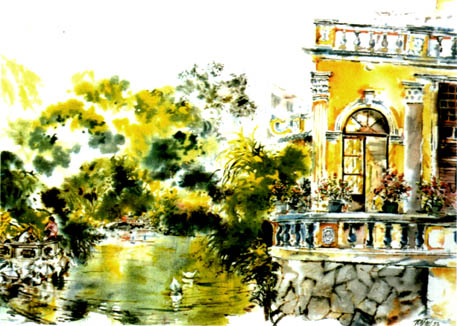
The Jardim do Lou Lim loc (Lou Lim loc Garden) Pavilion.
DIDIER RAPHAEL BAYLE (°1955).1993. Watercolour.
Collection of the artist.
The green areas were not always constantly expanding, as there have being times of setbacks, recalling the loss of gardens like the Jardim do Chunambeiro (Chunambeiro's Gar-den), the rows of trees along the Avenida de Vasco da Gama (Vasco da Gama Avenue), the Jardim de Po Hong (Po Hong Garden), on Rua de Entre-Campos (Entre-Campos Street) which, according to Ana Maria Amaro, were considered the oldest Chinese garden in Macao, or even the Jardim do Paço Episcopal (Bishophry Garden) which supposedly dated from the eighteenth century.
Pressures from urban expansion which profoundly changed the Territory in the last decades, contributed to the disappearance of a great number of houses with gardens and small farms, which had given the town a pleasant ambiance of space and colour, with their low walls decorated with small hedges, recorded in accounts and photos still with us today. In spite of this, one can see many accurate models like the part of Avenida do Conselheiro Ferreira de Almeida (Counselor Ferreira de Almeida Avenue) which was between Rua de Sacadura Cabral (Sacadura Cabral Street) and Estrada de Adolfo Loureiro (Adolfo Loureiro Road).
This is city which we still have the privilege to partially know that allows us to imagine pretty confidently, the ambiance which characterised the Macao spoken of up until the 1960's. From then on, and in a rapid way, homes were substituted by large buildings which by virtue of their exposed façades, were responsible for cutting down beautiful specimens of trees lining the streets. The saddest instance happened during the time of Governor Almeida e Costa (1982-1986) with the destruction of the Albano de Oliveira district, in which eight one storied houses were pulled down to make way for a car park of very doubtful use. Along with urban construction went the need to provide for the infrastructures which guaranteed an adequate response to the city's growth. This lead to, through the opening of ditches to install cables or place pipes either for sewage or the water supply, hundreds of trees having the circumference of their roots cut and weakened. As a consequence of this weakening, the trees not only became susceptible to disease, but lost their stability, and with typhoons, many of them ended up falling down, causing considerable damage.
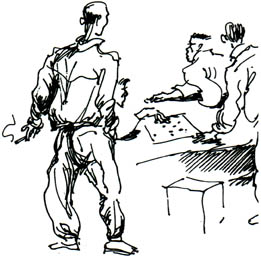
The importance of tree-lined streets is recognised today as having a calming effect, keeping in mind the fact that they contribute not only to beautifying towns but the fact that they also positively contribute, thanks to the benefits they bring in acting as a factor in controlling the climate as they calm down the excesses, to creating real tunnels of shade like those formerly thriving in several of Macao's main roads. However, today the conditions in which many of these trees grow are not always the most suitable and so it is understandable and not difficult to admit the possibility of intervention that would restore them to the quality of life necessary to carry out their role. Take for example the centre line of Avenida da Praia Grande (Praya Grande Avenue), the sector between Jardim de São Francisco (St. Francis' Garden) and Avenida do Dr. Mário Soares (Dr. Mário Soares Avenue) where a expedient measure, which seemed to be relatively easy to carry out, consisted in substituting the actual water-proof pavements, made on a cement or asphalt base, for a stone pavement which, apart from allowing better ventilation, contributed in ensuring a greater capacity for drainage, thereby giving a precious amount of water to the root systems, reducing the occurrence of flooding that often happened in the lower areas of the city. Although it can be thought of as a temporary inconvenience, this proposal does not reduce the number of parking lots already in existence, but does revert to the cobbled stone pavements so characteristic of Macao.
As a way of reducing the urban pressure on green zones, the old Lixeira do Canal dos Patos (Dump of the Waterway of the Ducks) was transformed into the Parque do Dr. Sun Yat Sen (Dr. Sun Zhongshan Park) in the mid-1980's, and the welcomed recent conversion of Colina de Mong Há (Mong Ha Hill) into a park which, situated in a densely populated area, was obviously going to be well received by the people there. It is hoped that this sequence of events will bring about other projects, specifically on Ilha Verde (Green Island) and Colina da Barra (Barra Hill), being equally in need of more green areas for their citizens to improve the quality of life.
The Zona de Aterros do Porto Exterior [ZAPE] (Reclamation Area of the Outer Harbour) and the Novos Aterros do Porto Exterior [NAPE] (New Reclamation Area of the Outer Harbour) have resulted in two gardens in the last decade, namely that of Jardim do Comendador Ho In (Commander Ho In Garden), with its twelve-thousand six-hundred square metres and the other, the Jardim do Dr. Carlos Assumpção (Dr. Carlos Asumpção Garden), with twenty three-thousand two-hundred and five square metres. The effort of the Macanese Leal Senado (Municipal Council) is very evident, also deserving mention is the recent rejuvenation of Colina da Guia (Guia Hill) which is now able to provide a greater range of activities and recreational facilities.
Thanks to the planting of hundreds of trees along streets, an obvious effort to provide green areas along highways culminated in December 1996 with over four-thousand one-hundred trees being planted in Macao.
According to information gathered up until 1996, there are 351,401 square metres of parks and gardens in Macao, and as far as the Islands are concerned there are 254,166 square metres; which with reference to each one have 18,068 and 65,817 respectively.
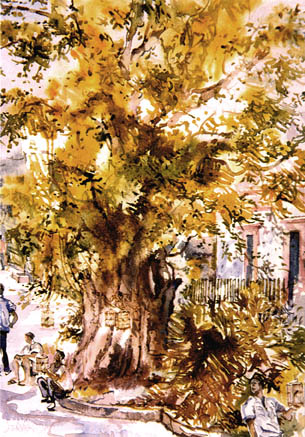
The Jardim de São Francisco (St. Francis' Garden).
DIDIER RAPHAEL BAYLE (°1955).
1997. Watercolour.
Collection of the artist.
In relationship to the Islands the development due to this effort is obvious, even apart from the fact that from this side what would be ideal in terms of a garden, specifically the Baixa de Taipa (Taipa Centre) is an area prepared to accommodate a greater population. In reality, the instigation of built up area was not in conjunction with the creation of parks, which although supported in essence, should take precedence over the building of tower blocks for in terms of quality of life, they can provide advantageous conditions fro the residents from the start. Although we cannot be sure that this sort of situation will not happen again in the Territory, which in retrospect can be a case of better late than never, the importance of a park's social function should be acknowledged.

Just as with people, we can come across botanical species which have the characteristic of being appropriate to the region, as with the case of Lychees [also: Litchi, Lichee or Leechee] (Port.: Lichias, Lat.: Litchi Sinensis -- (Sonn.)), the Longan or Dragon Fruit (Port.: Longane; Lat.: Euphoria longan -- Lour. (Steud.)), the Banyan Trees [or' St. Joseph's Trees' ] (Port.: Árvore de São José, Lat.: [Ficus Wightiana--?], Ficus virens --(Ait.)) and the Red Rhexia (Port.: Falsa Murta - Vermelha, Lat.: Melastoma sanguineum -- (Sims.)) or on the other hand others derived from distant places, like Eucalyptus (Port.: Eucalipto, Lat.: Eucalyptus) originally from Australia and Timor and Guavas (Port. Goiabadeira, Lat.: Psidium guajava) from South America, or the Castor Oil Plant (Port.: Rícino, Lat.: Ricinus Communis) from Africa, and Fig Trees (Port.: Figueira, Lat.: Ficus caryaca) and Willows or Sallows (Port.: Salgueiro, Lat.: Salus) from Europe. As we all Know, it is impossible to determine the exact period when a specific species was introduced, and far less the circumstances under which it occurred. Such a situation is totally under-stood as rarely is the importance of exotic botanical species predicted for normally they happen by chance and have to do with people's individual taste. This was what happened for example with the Acacia Rubra, which was not mentioned in the list of plants from Macao and Timor organised by the Head of the Services de Saúde (Public Health Service), Dr. José Gomes da Silva, but in 1933, Aires Carlos da Sá Nogueira admitted their introduction after 1886, the year when the list was published in the "Boletim Oficial" ("Official Bulletin").
From first hand experience, for example, Teak (Port.: Árvore da Teca, Lat.: Tectona grandis) was introduced at the beginning of the 1960's by technical people from the Missão de Estudos Agronómicos de Macau (Mission of Agronomic Studies of Macao) which brought it from Timor; the African Tulip Tree [lit.] (Port.: Tulipeiro Africano, Lat.: Spathodea campanulata -- (Beauv.)) was introduced in 1980-1981, thanks to the exchange of seeds between the Services Florestais e Agrícolas de Macau (Department of Agriculture and Forestry of Macao) and scientific institutions like Botanical Gar dens; the That Cinammon [a variety of Senna] (Port.: Acacia da Tailândia, Lat.: Cassia Spectabilis -- (DC.)) was sent from Bangkok at our request in 1981 -1982, just like what happened with the Malabar Almond, Country Almond or Indian Almond (Port.: Castanheiro da Índia, Lat.: Terminalia catappa) which roughly at the same time was offered by the of Hong Kong Urban Council or even the Auricular Cinammon [lit.] (Acacia auriculae formisa -- (A. Cunn), which came up as a species used in the reforestation projects carried out in 1984 by the Forest Service of Guangdong Province.
Ana Maria Amaro highlighted the situation very well by saying,"[...] Macao's actual flora is nothing more than the result of intermittent attempts at adapting by the enormous variety and number of species, from which some would not acclimatise, and others would find conditions difficult to thrive in and would neither bear fruit or survive, being condemned to extinction, and others still would completely adapt, and even become confused with indigenous plants and associated with the area."
Translated from Portuguese by: Linda Pearce
* Former technician of the Brigada de Macau (Macao Corps) of the Missão de Estudos Agronómicos do Ultramar (Over-seas Mission of Studies on Agronomics), former technician and head of the Serviços Florestais e Agrícolas de Macau (Department of Agriculture and Forestry of Macao), full member of the Board of the Comissão Administrativa da Câmara Municipal das Ilhas (Municipality of the Islands [Taipa and Coloane]), member of the Board of the Conselho Consultivo do Governador ([Macao] Governor's Advisory Council), member of the Conselho do Ambiente (Environ-mental Council), etc.